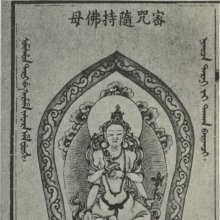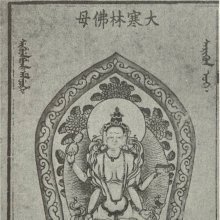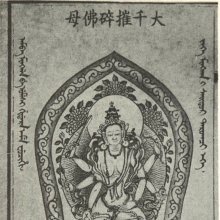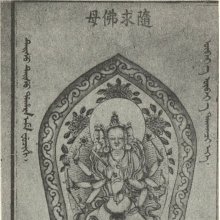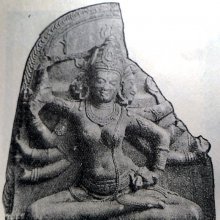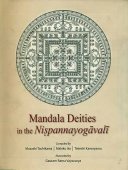Pancaraksha, Pañcarakṣā, Panca-raksha: 9 definitions
Introduction:
Pancaraksha means something in Buddhism, Pali, Hinduism, Sanskrit. If you want to know the exact meaning, history, etymology or English translation of this term then check out the descriptions on this page. Add your comment or reference to a book if you want to contribute to this summary article.
The Sanskrit term Pañcarakṣā can be transliterated into English as Pancaraksa or Pancaraksha, using the IAST transliteration scheme (?).
Alternative spellings of this word include Pancharaksha.
Images (photo gallery)
(+8 more images available)
In Buddhism
Tibetan Buddhism (Vajrayana or tantric Buddhism)
Source: archive.org: The Indian Buddhist IconographyPañcarakṣā (पञ्चरक्षा) or simply Rakṣa, refers to the five protectresses (deities) as they are called in Tantric works. The Pañcarakṣā deties are popular and well-known amongst the Mahāyāna Buddhists, particularly of Nepal. A manuscript copy of the Pañcarakṣā describing the five Rakṣā deities, their worship on different occasions and their powers, is to be found in almost every Buddhist house-hold in Nepal. [...]. The Pañcarakṣā is recited in all varieties of domestic difficulties, such as, illnesses, adversities, loss of wealth, cattle, etc.
The five Pañcarakṣā deities according to the Niṣpannayogāvalī are:
- Mahāpratisarā,
- Mahāsāhasrapramardanī,
- Mahāmantrānusāriṇī,
- Mahāśītavatī,
- Mahāmāyūrī.

Tibetan Buddhism includes schools such as Nyingma, Kadampa, Kagyu and Gelug. Their primary canon of literature is divided in two broad categories: The Kangyur, which consists of Buddha’s words, and the Tengyur, which includes commentaries from various sources. Esotericism and tantra techniques (vajrayāna) are collected indepently.
Mahayana (major branch of Buddhism)
Source: Brill: Śaivism and the Tantric Traditions (mahayana)Pañcarakṣā (पञ्चरक्षा) refers to one of the Navadharma (“collection of nine texts”) employed for ritualistic practices in Kathmandu Valley, in the era of Mahindra Vira Vikram Shah (r. 1955–1972).—Cf. Tuladhar–Douglas 2006, 144–147 and von Rospatt 2015, 819–821. The latter remarks that “these canonical works are not so much studied for their content as liturgically recited or put to other ritual uses”.

Mahayana (महायान, mahāyāna) is a major branch of Buddhism focusing on the path of a Bodhisattva (spiritual aspirants/ enlightened beings). Extant literature is vast and primarely composed in the Sanskrit language. There are many sūtras of which some of the earliest are the various Prajñāpāramitā sūtras.
General definition (in Buddhism)
Source: Wisdom Library: Dharma-samgrahaPañcarakṣā (पञ्चरक्षा) refers to the “five protectors” as defined in the Dharma-saṃgraha (section 5):
- Pratisarā (assailer),
- Sāhasrapramardanī (thousands-crusher),
- Mārīcī (moonlight),
- Mantrānusāriṇī (mantra-follower),
- Śītavanī (cool wood).
The Dharma-samgraha (Dharmasangraha) is an extensive glossary of Buddhist technical terms in Sanskrit (e.g., pañcarakṣā). The work is attributed to Nagarguna who lived around the 2nd century A.D.
Source: DLMBS: BuddhānusmṛtiPañcarakṣā (पञ्चरक्षा), that is, the “collection of the five dhāraṇīs” is popular in Nepal. These five protecting spells include:
- mahā-pratisarā (for protection against sin, disease and evils),
- mahā-sahasrapramardinī (for protection against evil spirits),
- mahā-māyūrī or vidyārājñī (for protection against snake-poison),
- mahā-śītavatī (for protection against 'cruel' planets, cruel animals and poisonous insects), and
- mahā rakṣā mantrānusāriṇī (for protection against diseases).
Pañcarakṣā (पञ्चरक्षा, “five protections”) consists of:
- Mahāpratisarā,
- Mahāmāyūrī,
- Mahāsāhasrapramardanī,
- Mahāmantrānusāriṇī,
- Mahāśītavatī (in various sequences).
The earliest evidence for texts grouped together as the “five great dhāraṇīs” comes from Tibetan catalogues around 800 CE. These scriptures include spells, enumerations of benefits and ritual instructions for use.
Languages of India and abroad
Sanskrit dictionary
Source: Cologne Digital Sanskrit Dictionaries: Aufrecht Catalogus CatalogorumPañcarakṣā (पञ्चरक्षा) as mentioned in Aufrecht’s Catalogus Catalogorum:—vedānta. Oppert. 2366. 5081.
Source: Cologne Digital Sanskrit Dictionaries: Monier-Williams Sanskrit-English DictionaryPañcarakṣā (पञ्चरक्षा):—[=pañca-rakṣā] [from pañca] f. Name of [work]
[Sanskrit to German]
Sanskrit, also spelled संस्कृतम् (saṃskṛtam), is an ancient language of India commonly seen as the grandmother of the Indo-European language family (even English!). Closely allied with Prakrit and Pali, Sanskrit is more exhaustive in both grammar and terms and has the most extensive collection of literature in the world, greatly surpassing its sister-languages Greek and Latin.
See also (Relevant definitions)
Partial matches: Raksha, Panca.
Starts with: Pancarakshaka, Pancarakshamandala.
Full-text: Maharaksha, Pratisara, Raksha, Pancarakshamandala, Marici, Mantranusarini, Shitavani, Sahasrapramardani, Five Protectors, Navadharma, Mantranudharini, Navagrantha, Sitavati, Karotapani, Dharani, Mahamantranusarini, Mahamayuri, Mahapratisara, Mahashitavati, Mahasahasrapramardani.
Relevant text
Search found 1 books and stories containing Pancaraksha, Pañcarakṣā, Panca-raksha, Pañca-rakṣā, Pancaraksa, Panca-raksa, Pañcarakṣa; (plurals include: Pancarakshas, Pañcarakṣās, rakshas, rakṣās, Pancaraksas, raksas, Pañcarakṣas). You can also click to the full overview containing English textual excerpts. Below are direct links for the most relevant articles:
Related products

